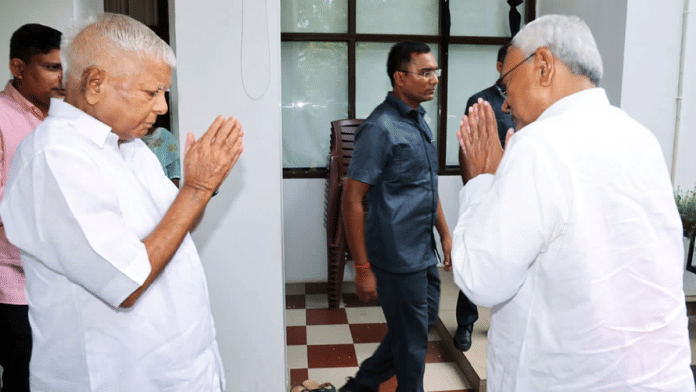The issue of reservations in government jobs and educational institutes has been a part of Bihar politics since the 1970s when Karpoori Thakur pushed for a 27 per cent quota for backward castes in Bihar. On Thursday, after the Bihar assembly unanimously approved the new reservation bill, increasing the quota limit for Other Backward Classes, Extremely Backward Castes, Scheduled Castes, and scheduled Tribes from 50 per cent to 65 percent, Chief Minister Nitish Kumar remarked, “Let’s urge the Centre to conduct a national census on caste, and if needed, increase reservation.”
Once the governor approves, Bihar will join Tamil Nadu and Maharashtra as states where quota is above 50 per cent. Less than six months before the 2024 Lok Sabha election, this political move opens the campaign up and marks a win for the JDU-RJD in the way that the BJP is forced to toe the quota line. This is why Bihar’s 65 per cent quota increase is ThePrint’s Newsmaker of the Week.
Background
Efforts to increase the quota in Bihar were underway even before Nitish Kumar joined hands with the RJD. Like Lalu Prasad, Nitish had always advocated for a caste census. Even when he was with the NDA, he led an all-party meeting to meet Prime Minister Narendra Modi, demanding a caste survey in August 2021. Although PM Modi gave a patient hearing, he turned down the demand. That sowed the seeds of his return to the Mahagathbandhan (Grand Alliance) fold, with caste census emerging as a key factor that drew him closer to the RJD.
The caste census in Bihar was conducted in two phases—7 January to 24 January 2023, and 15 April 2023 to 5 August. Legal hurdles delayed the second phase with the Patna High Court stay on census lifting only in July. The results of the caste survey was released on 2 October.
Also read: India has gone into data discomfort. Explains silence on Bihar caste inequality
BJP in a bind
The caste survey has put Bihar BJP on the defensive. While the state unit supported the caste survey and increase in quota, the party’s national leadership was not on board. PM Modi, after the release of the caste survey, said that the poor constituted the largest caste. On Thursday, BJP MLAs defended their reservation track record, asserting their historical support for reservation. “Reservation for backward castes happened when we were a part of Karpoori Thakur government in the 1970s. Reservation for EBCs in panchayat elections when we were a part of the Nitish Kumar government in 2005. It was not RJD but us who gave reservations,” said former minister Nand Kishore Yadav while addressing the debate on increased quota. The debate turned into a verbal clash, with both the Grand Alliance and BJP claiming credit.
As the political landscape shifts, the implications of the caste survey are becoming clearer. Many leaders are questioning the authenticity of the caste survey’s findings, suggesting that the numbers may not accurately reflect the true demographics of Bihar.
The BJP was not caught off guard by Nitish’s move, as the caste survey report backfired on him. ‘Upper caste’ remained silent, and backward caste leaders accused the ruling alliance of manipulating the survey to boost their supporters’ numbers while reducing the population figures of other caste groups. “Without increasing reservation numbers, Nitish Kumar cannot politically benefit,” remarked a senior BJP leader. The BJP, despite being known as the upper-caste party in Bihar, has to toe Nitish’s line.
Nitish’s needs
Nitish Kumar’s primary support base consists of Kurmis, Kushwahas, and a section of EBCs. In the 2014 Lok Sabha election, when he contested alone, his vote percentage was slightly above 15 per cent. Recent bypolls suggest that the BJP is making inroads into his vote bank. In December 2022, the BJP was able to wrest Kurhani assembly seat from the Grand Alliance despite the support of RJD, Congress, and Communists. “What better ways are there to boost the support base than increase the quota and have a Mandal 2.0,” said a JDU minister, pointing out that the OBCs and EBCs constitute 63 per cent of Bihar’s population. The recent hike increased the quota for OBCs from 12 per cent to 18 per cent, EBCs from 18 per cent to 25 per cent, SCs from 16 per cent to 20 per cent, andSTs from 1 per cent to 2 per cent.
Also read: Bihar census identified privileged and under-privileged castes. Go national now
Quota politics
Historically, quota politics in Bihar has been turbulent, leading to social tension. In the 1970s, when Karpoori Thakur introduced a quota for backward castes, abuses were hurled publicly against him. In 1993, when Lalu Prasad implemented the Mandal Commission recommendations, it led to caste violence in several places in Bihar.
In contrast, the recent caste survey hardly created a ripple in the upper castes. Former MLC and once a close associate of Nitish Kumar, Prem Kumar Mani is of the view that the revised quota will not have a meaningful impact. “In the early days, socialist leaders like Ram Manohar Lohia spoke about using caste to create a classless society. After 1990, leaders forgot class and stressed on caste like Khap [panchayat] leaders. The thing is that reservation has become like a cow that does not give any milk any longer. The same issue cannot be used again and again,” he said.
Views are personal.
(Edited by Prashant)






